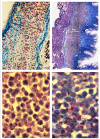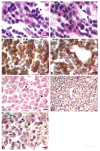Hematopoietic stem cells debut in embryonic lymphomyeloid tissues of elasmobranchs
- PMID: 31577110
- PMCID: PMC6778817
- DOI: 10.4081/ejh.2019.3060
Hematopoietic stem cells debut in embryonic lymphomyeloid tissues of elasmobranchs
Abstract
The evolutionary initiation of the appearance in lymphomyeloid tissue of the hemopoietic stem cell in the earliest (most primitive) vertebrate model, i.e. the elasmobranch (chondroichthyan) Torpedo marmorata Risso, has been studied. The three consecutive developmental stages of torpedo embryos were obtained by cesarean section from a total of six pregnant torpedoes. Lymphomyeloid tissue was identified in the Leydig organ and epigonal tissue. The sections were treated with monoclonal anti-CD34 and anti-CD38 antibodies to detect hematopoietic stem cells. At stage I (2-cm-long embryos with external gills) and at stage II (3-4 cm-long embryos with a discoidal shape and internal gills), some lymphoid-like cells that do not demonstrate any immunolabeling for these antibodies are present. Neither CD34+ nor CD38+ cells are identifiable in lymphomyeloid tissue of stage I and stage II embryos, while a CD34+CD38- cell was identified in the external yolk sac of stage II embryo. The stage III (10-11-cm-long embryos), the lymphomyeloid tissue contained four cell populations, respectively CD34+CD38-, CD34+CD38+, CD34-CD38+, and CD34-CD38- cells. The spleen and lymphomyeloid tissue are the principal sites for the development of hematopoietic progenitors in embryonic Torpedo marmorata Risso. The results demonstrated that the CD34 expression on hematopoietic progenitor cells and its extraembryonic origin is conserved throughout the vertebrate evolutionary scale.
Figures




References
-
- Zon Li. Developmental biology of hematopoiesis. Blood 1995;86:2876-91. - PubMed
-
- Dzierzak E, Medvinsky A, de Bruijn M. Qualitative and quantitative aspects of haematopoietic cell development in the mammalian embryo. Immunol Today 1998;19:228-36. - PubMed
-
- Tavian M, Coulombel L, Luton D, Clemente HS, Dieterlen-Lievre F, Peault B. Aorta-associated CD34+ hematopoietic cells in the early human embryo. Blood 1996;87:67-72. - PubMed
-
- Tavian M, Hallais MF, Peault B. Emergence of intraembryonic hematopoietic precursors in the preliver human embryo. Development 1999;126:793-803. - PubMed
MeSH terms
Substances
LinkOut - more resources
Full Text Sources
Medical
Research Materials

